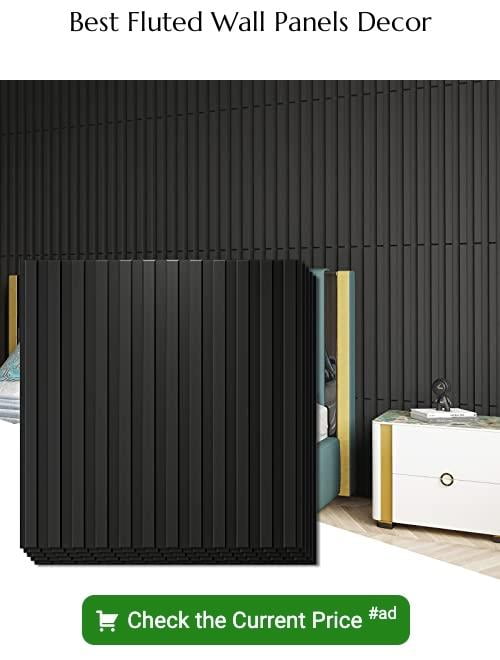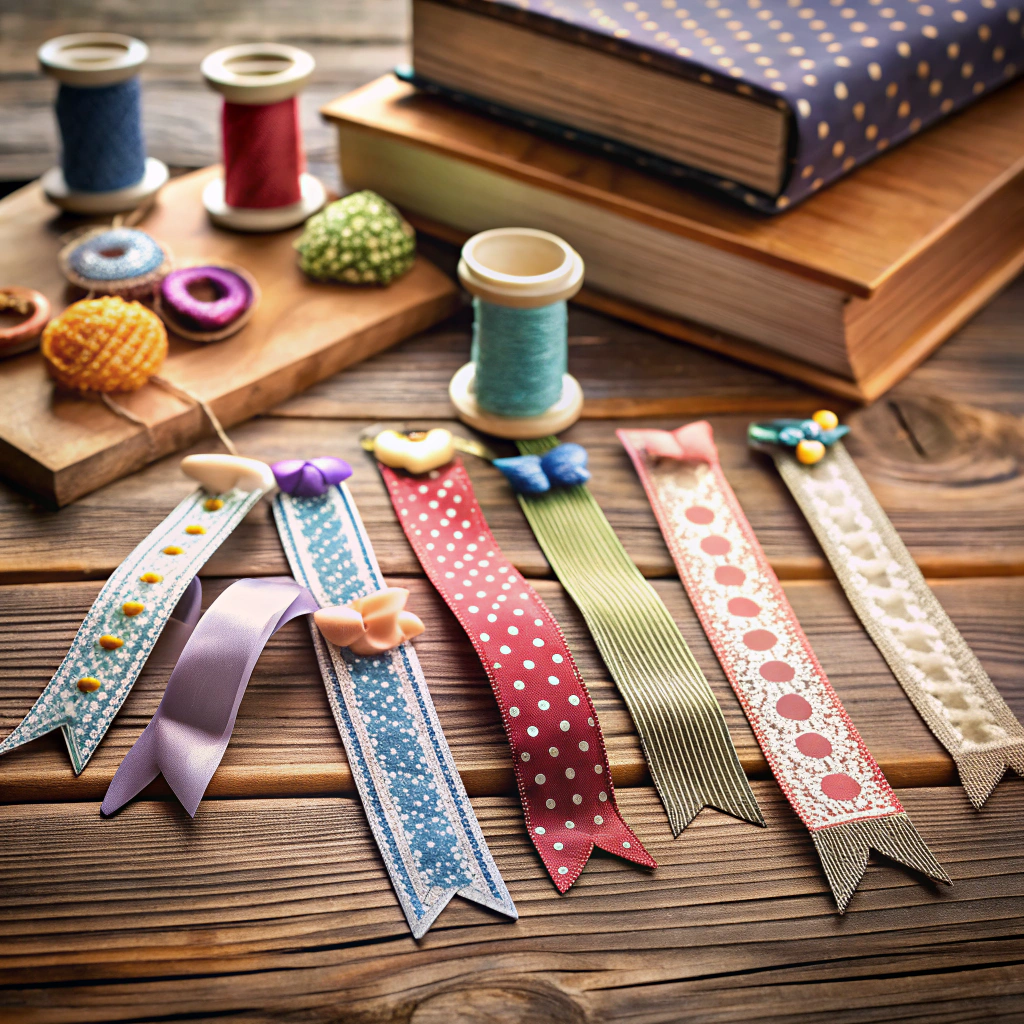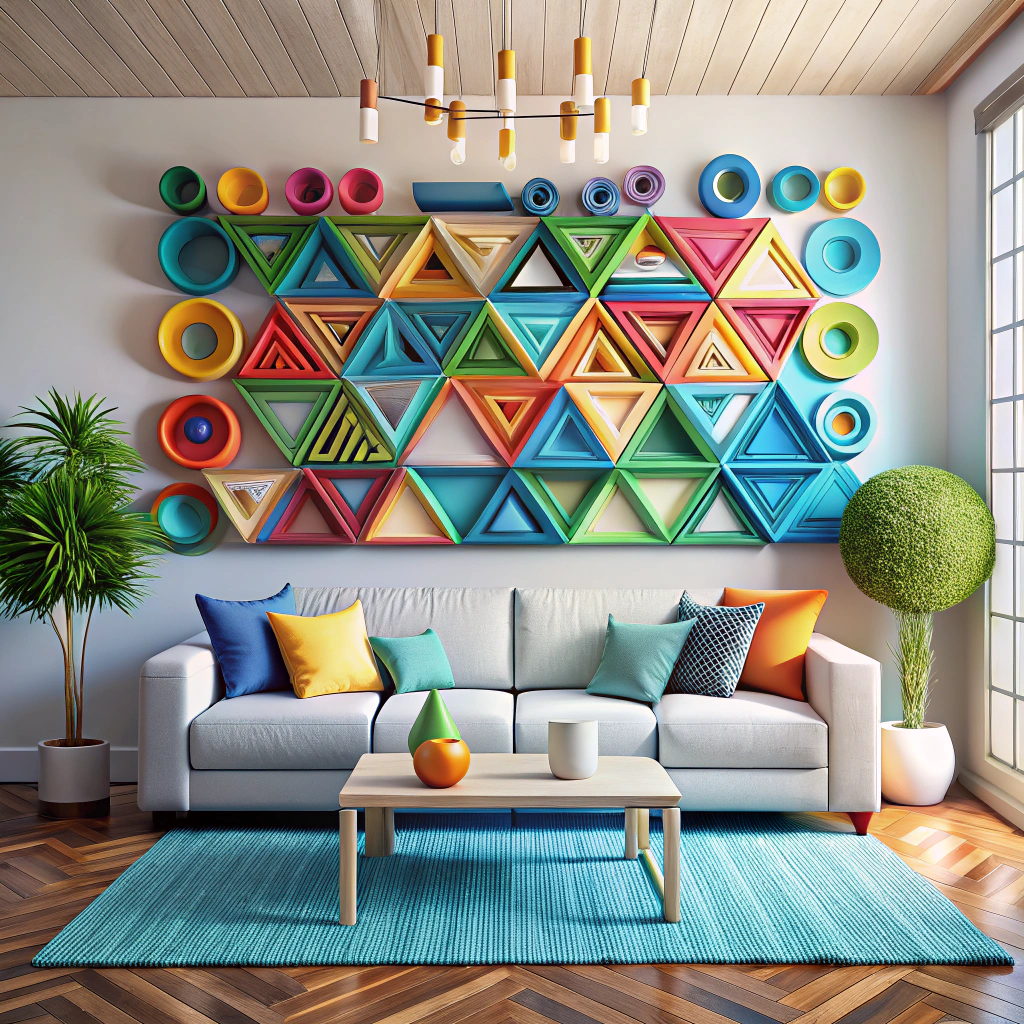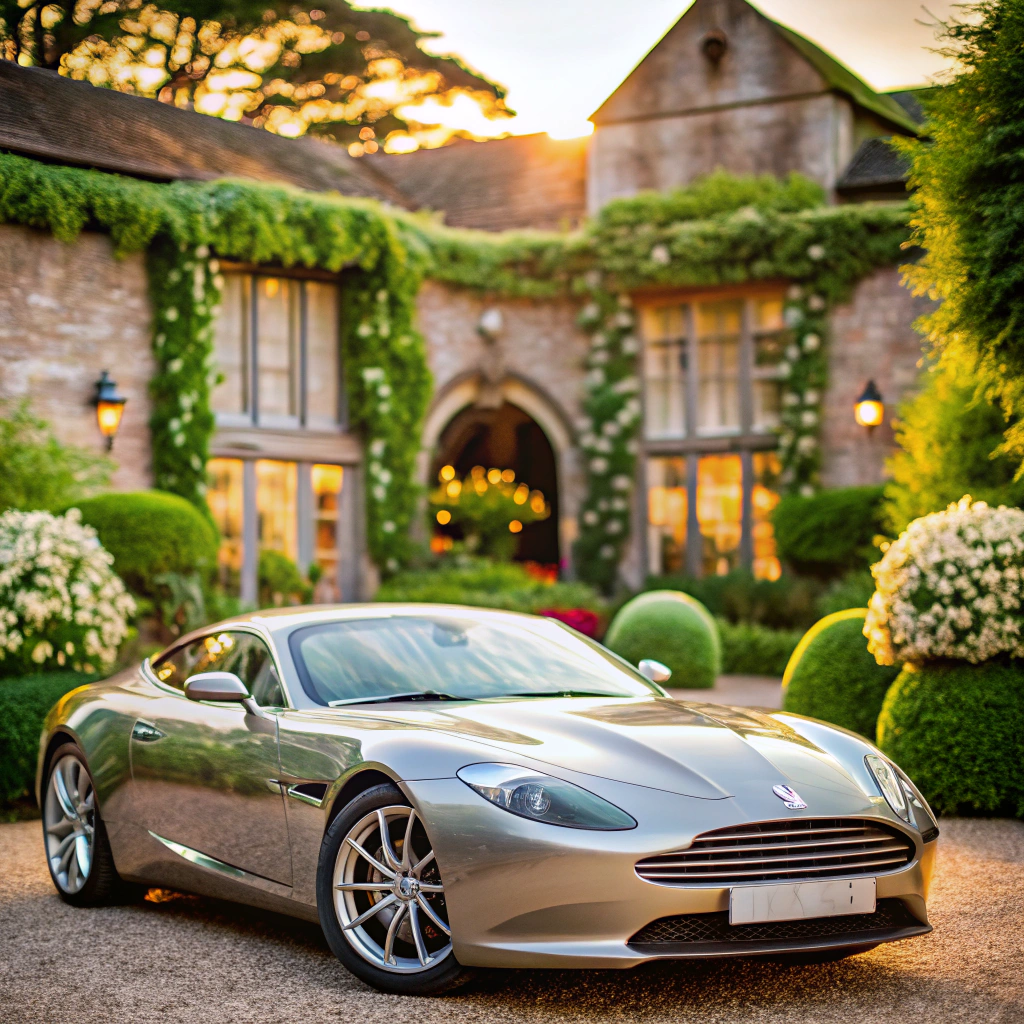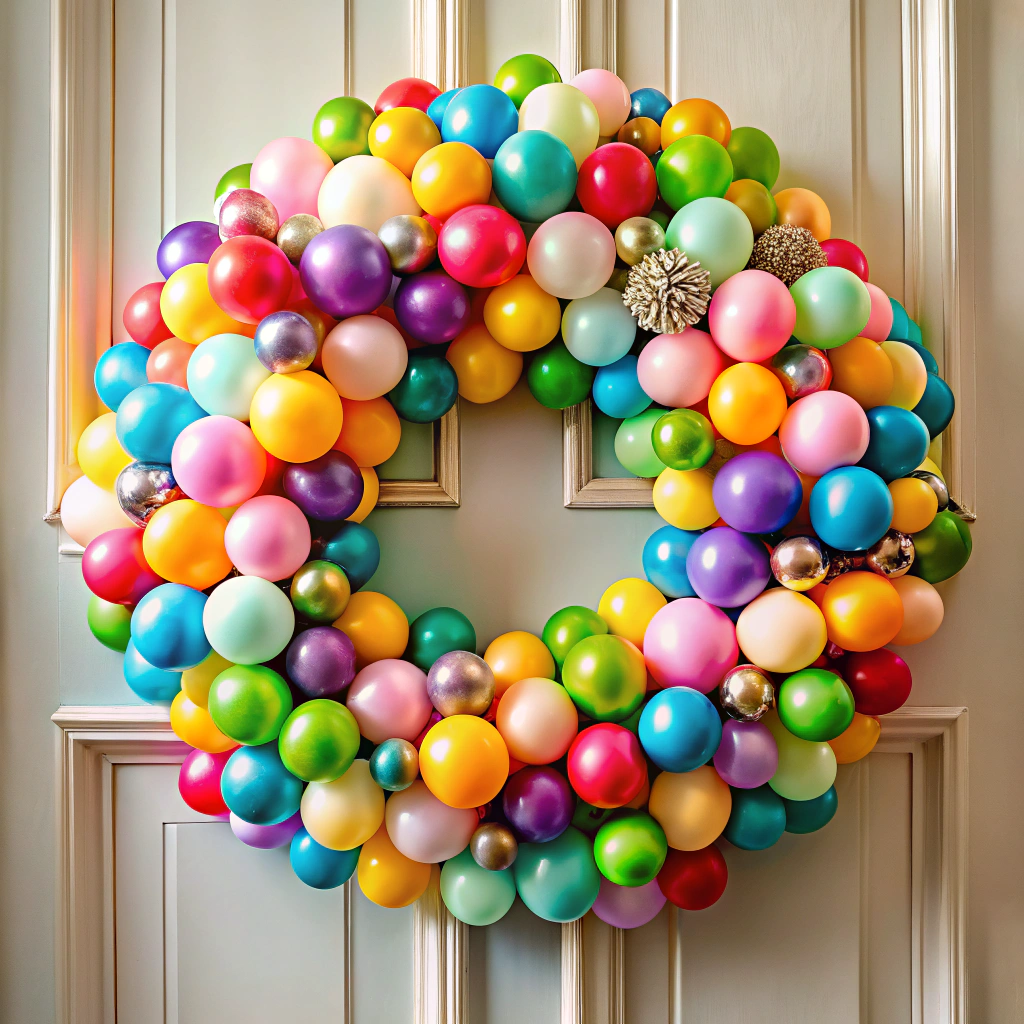Last updated on
Explore creative decor ideas with fluted panels because they offer a distinctive charm while elevating the aesthetic appeal of any living space.
“I am proud to present my article on ’20 Fluted Panel Decor Ideas,’ complete with my original designs, and I sincerely hope it not only inspires you, but also grants you the same joy I experienced while creating them.”
Fluted panels, with their distinctive vertical grooves, can add an elegant touch to any room. Whether you’re looking to create a bold statement wall or subtly enhance your interior, these versatile panels can be used in a variety of ways.
From kitchen cabinets to bedroom walls, fluted panels can transform ordinary spaces into extraordinary ones. In this article, you’ll discover a wealth of decor ideas using fluted panels, each one designed to inspire and guide you in making the most of this stylish design element.
Stay tuned for all the details, tips, and tricks to make your fluted panel project a success.
Install Fluted Panels As Unique Kitchen Backsplash
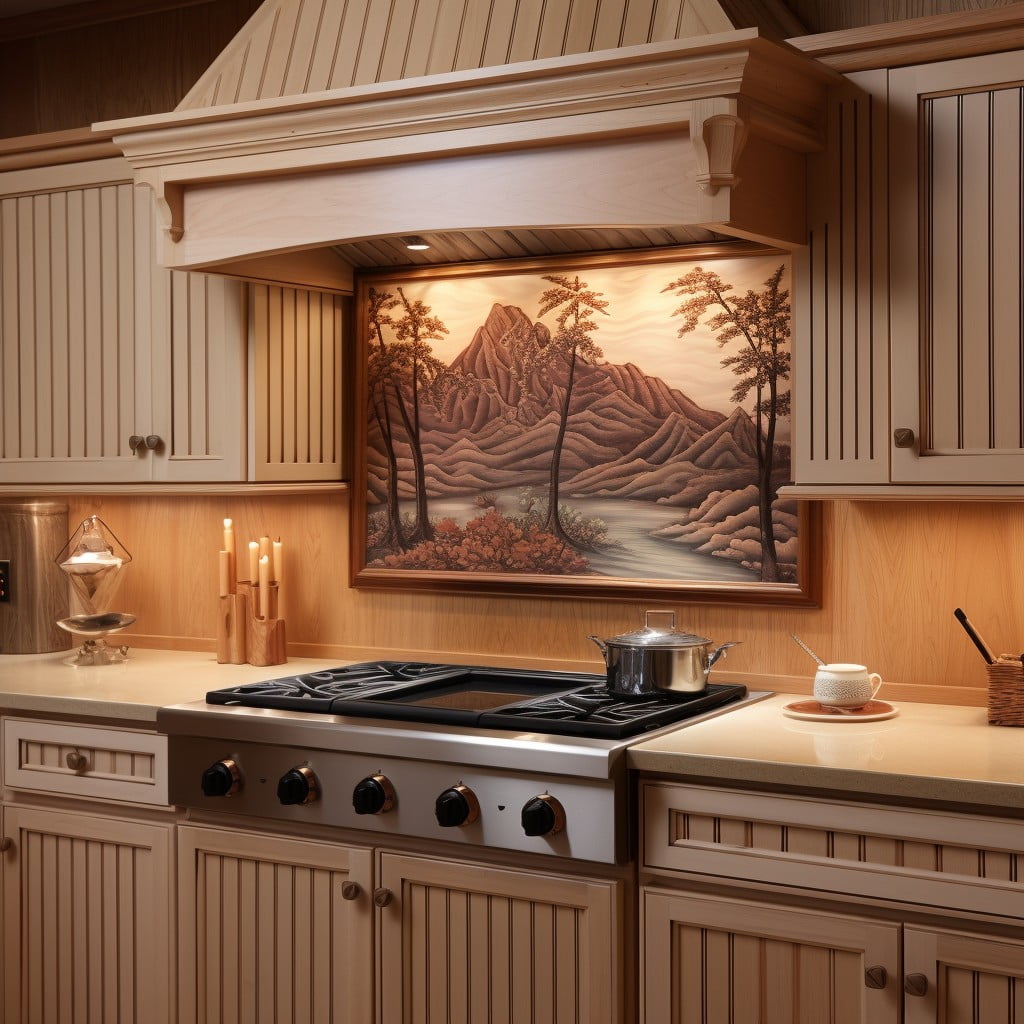
In the heart of your home, the kitchen, fluted panels can take on a new life as a stylish and much unexpected backsplash. With an ability to elevate the overall aesthetic, they add texture and depth while seamlessly blending into various design styles. Fluted panels work exceptionally well in a minimalist, modern kitchen, adding an architectural feature to a sleek design.
Here are some key considerations to incorporate this unique element:
- Match the fluted panels with cabinetry or paint them a contrasting color for a pop.
- Coordinate fluted panels with countertops to create a cohesive look.
- For a more dramatic look, use fluted panels that stretch from the countertop to the ceiling.
- Consider the material of the fluted panels, as they will need to be water-resistant and easy to clean.
- Also, the size of the flutes (the grooves in the panel) can greatly affect the overall appearance. Smaller flutes will provide a subtle, elegant look, while larger ones offer more of a bold statement.
- Remember to add proper lighting to accentuate the texture of the panels.
With mindful use, fluted panels can transform a mundane backsplash into a chic design feature, elevating the overall kitchen look!
Create an Accent Wall in the Living Room
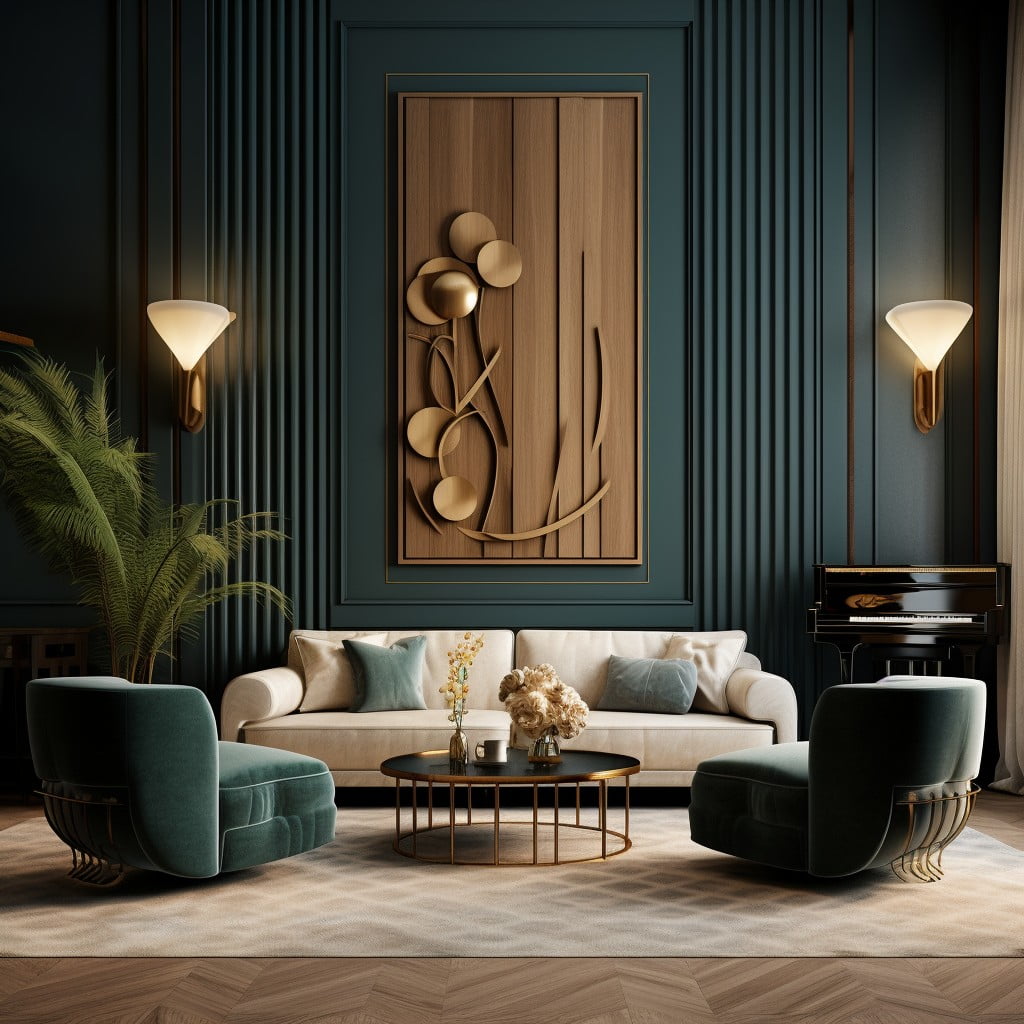
Fluted panels are perfect for transforming an ordinary living room wall into an aesthetic accent feature. To achieve this, firstly choose a wall that naturally draws the eye; typically the one behind your main sofa or TV unit.
Then, consider your color palette. You might opt for a tone that complements your current theme or choose a contrasting color for a bold statement.
Next, plan your fluting. Vertical flutes create a feeling of height and grandeur, while horizontal flutes add width to the room, making it look more spacious.
You can apply fluted panels in a full or partial manner. Full application covers the entire wall, delivering a sophisticated, seamless look. Partial application, on the other hand, involves using fluted panels for a section of the wall, offering a delightful visual contrast.
Remember to incorporate lighting to enhance the shadows between the flutes; this will provide greater depth and interest to your wall. This can be achieved with adjustable spotlighting, or even mood lighting such as wall sconces or floor lamps.
Lastly, consider the scale of the fluting. Wide fluting can give a modern twist to your decor, while narrower fluting delivers a more traditional and classic aesthetic. By carefully considering these points, your living room accent wall will radiate style.
Use Fluted Panels As Headboard Designs in Bedroom
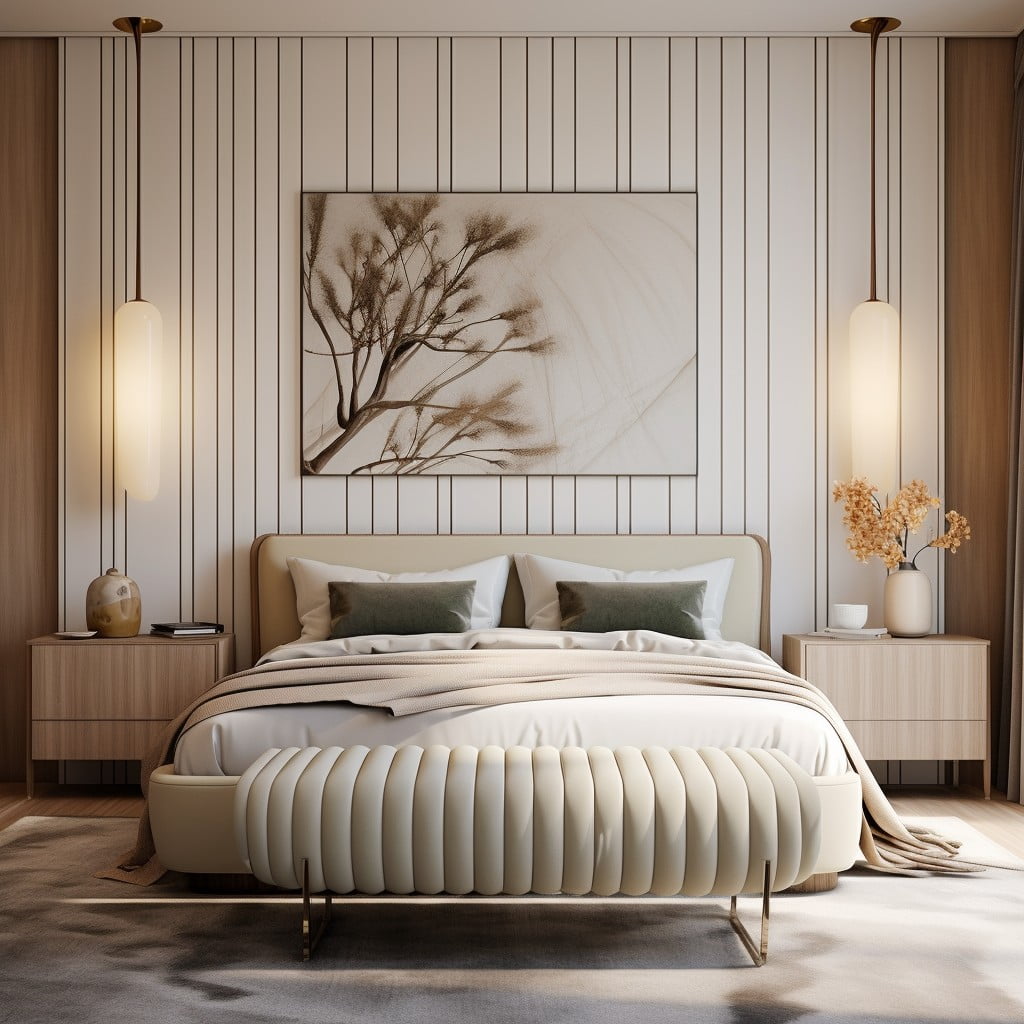
With varying ridge widths and depths to work with, panels present a range of creative possibilities. They are an excellent choice for adding depth and texture to your bedroom decor. Not confined to walls only, these design elements can turn a simple bed into a standout feature when used as a headboard.
Instead of a traditional fabric headboard, a panel with deep grooves creates a striking visual impact. When integrated with cozy bedside lighting, the headboard exhibits a captivating interplay of light and shadow.
Another idea is to paint the fluted panel in a bold hue for a touch of color intrigue. Complementing it with minimalist decor can bring balance and contemporary style to your sleeping space.
Customizing the headboard size according to bed dimensions presents the opportunity for personalized aesthetic detailing. For those who prefer a luxurious feel, extending the panel across the entire wall behind the bed serves as a focal point and creates an illusion of a larger room.
Consider upholstering the panel in fabric for extra warmth and comfort, or leave the ripples raw to emphasize the natural texture and craftsmanship.
Regardless of the chosen design route, fluted panels pose an affordable yet high-impact solution for transforming your bedroom’s architectural features. It propels more than function; it is about creating a unique identity defining one’s personal style.
Design a Fluted Panel Sliding Door for Rooms
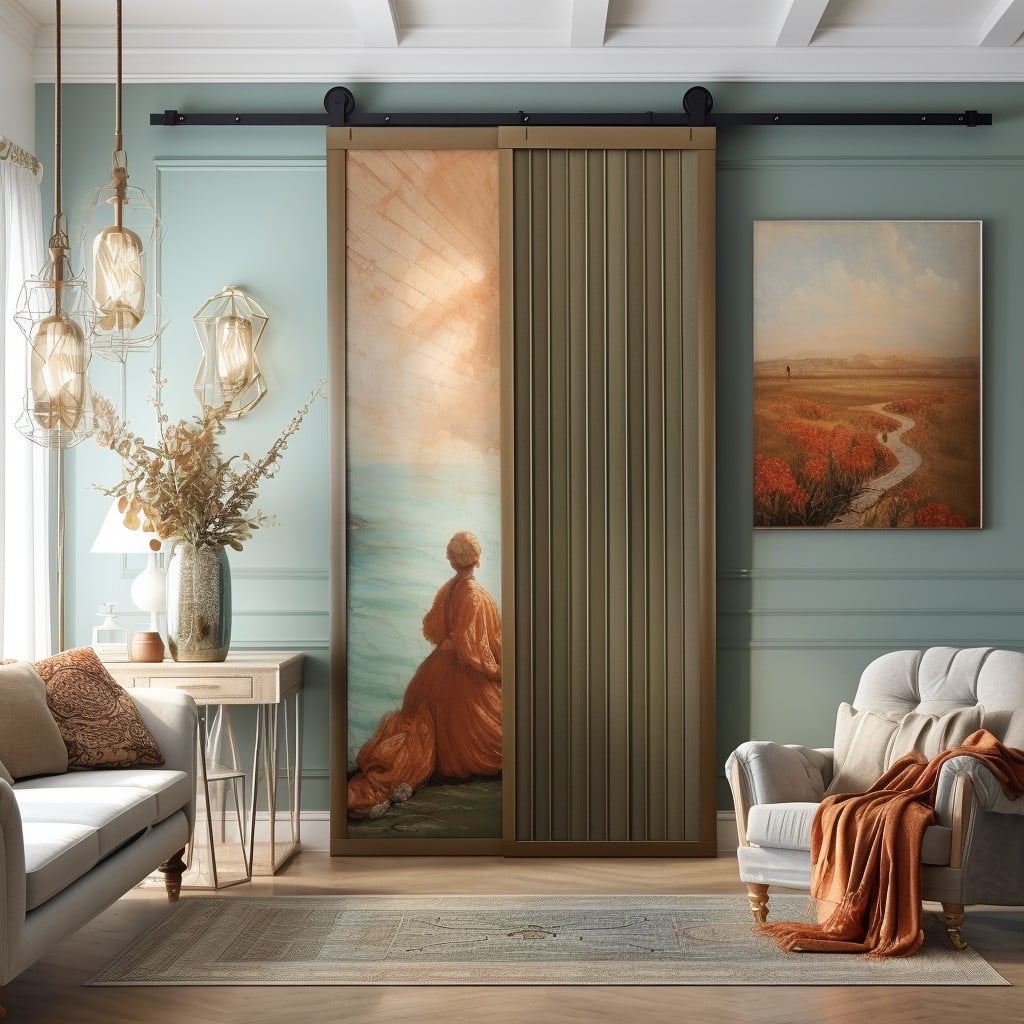
Creating a fluted panel sliding door can be a brilliant way to add interest to your interiors. The aesthetic flexibility and practical functionality of fluted panels work perfectly with a sliding door mechanism.
– This design can save valuable floor space by eliminating the door swing area. It is ideal for small rooms or apartments.
– As fluted panels come in a variety of materials including wood and metal, you can choose based on your room’s design and color scheme.
– For a minimalist look, consider a white or light-colored fluted panel sliding door. For something more dramatic, opt for a darker shade.
– To customize further, you can combine different sizes of fluting or use dual-tone colors.
– Adding a mirrored surface to one side of the fluted panel door can transform it into a full-length mirror, providing dual functionality.
– Subtle lighting on the top or sides of the sliding door can emphasize the fluting, creating stunning shadows and adding depth to the room.
Remember to ensure the track mechanism for the sliding door is strong enough to hold the weight of the fluted panel door for safe and easy operation.
Use Fluted Panels for Wardrobe or Cabinet Doors
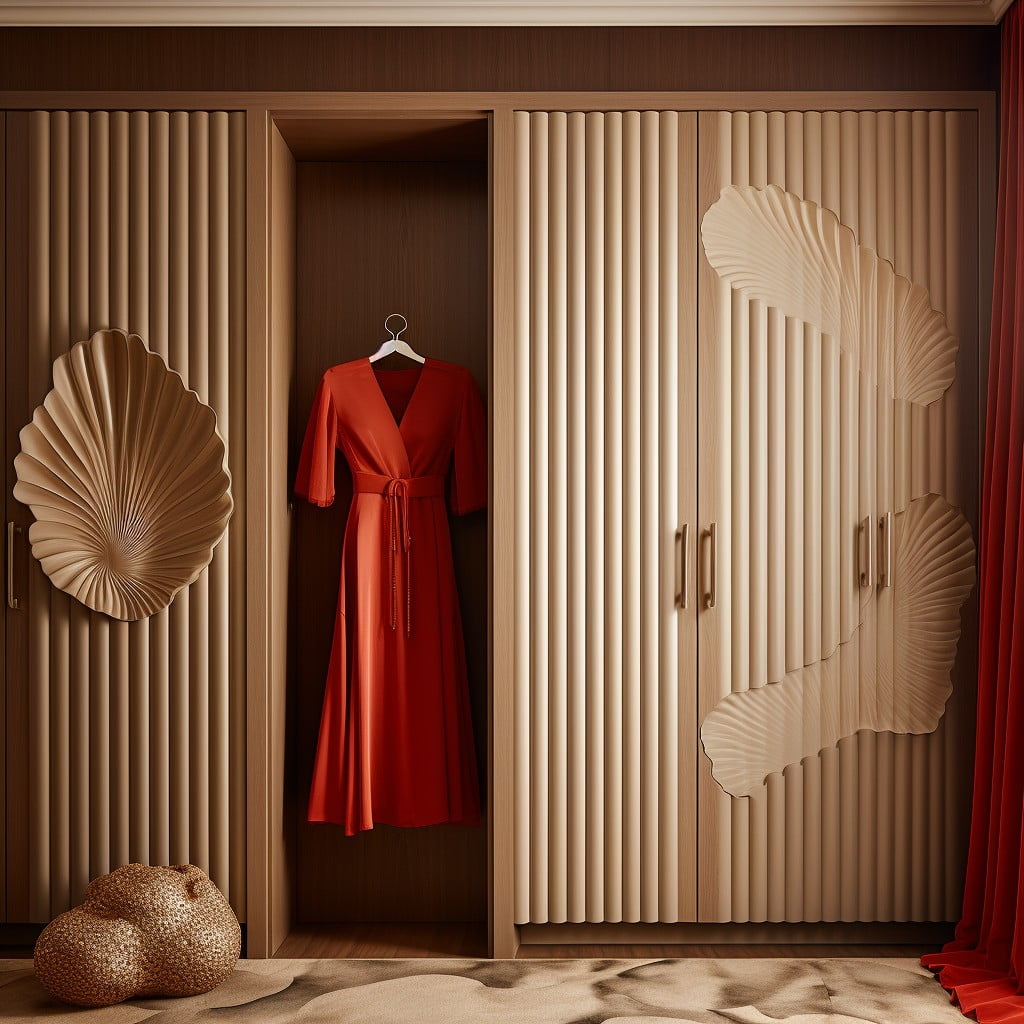
Incorporating fluted panels into wardrobe or cabinet doors can transform furniture into statement pieces. They offer a unique way to add sophistication and subtle interest to an otherwise simple room design.
1. Material: Fluted panels are primarily available in two materials – wood and MDF. Wood delivers a timeless classic look, while MDF can present a modern vibe with a matte finish.
2. Alignment: These panels should align with the overall design – vertical flutes create an illusion of height in smaller rooms, while horizontal ones can give a sense of width into narrow spaces.
3. Color: Opt for neutrals to maintain a calm palette, or go bold with dynamic hues, ensuring it complements the color scheme of the room to create a cohesive look.
4. Features: Opting for tall, slim flutes can create a more elegant and contemporary look, whereas shorter, wider flutes yield a traditional feel.
5. Hardware: To highlight the fluted pattern, consider minimalist handles, knobs, or even handleless designs. The right hardware can elevate the overall appeal of the doors.
Consider these points when integrating fluted panels to your cabinet or wardrobe doors to achieve a bespoke aesthetic that’s uniquely you.
Install Fluted Panels in the Hallway for Aesthetic Appeal
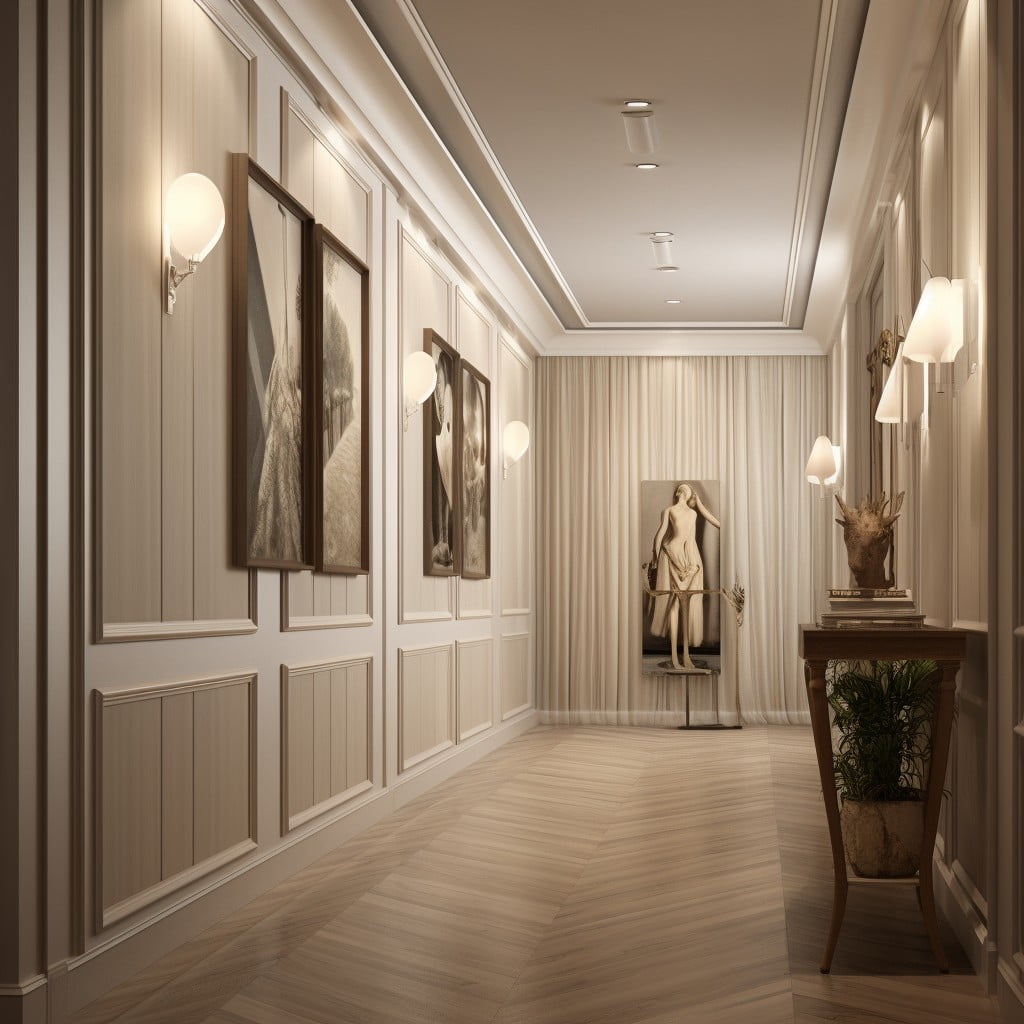
Fluted panels can make a dramatic statement in your hallway. Here are some ideas:
1. Delineate your space: Position fluted panels along the length of your hall to lead the eye and provide rhythm and structure to an often-neglected space.
2. Enhance lighting: With their vertical lines, fluted panels can help bounce light around the hall, making it feel more spacious.
3. Create contrast: The panels’ grooves and ridges can add an intriguing contrast against smooth surfaces. Pair them with minimalist accents for a calming aesthetic or with bold colors for a vibrant atmosphere.
4. Easy maintenance: Besides being stylish, fluted panels are also practical. They are easy to clean and conceal knocks, making them perfectly suitable for high-traffic areas like hallways.
Remember, the configuration, colors, and materials you choose for your fluted panels can drastically alter the overall feel of your hallway. Experimenting with these variables will allow you to personalize the aesthetic appeal of the space.
Create a Fluted Panel Fireplace Surround
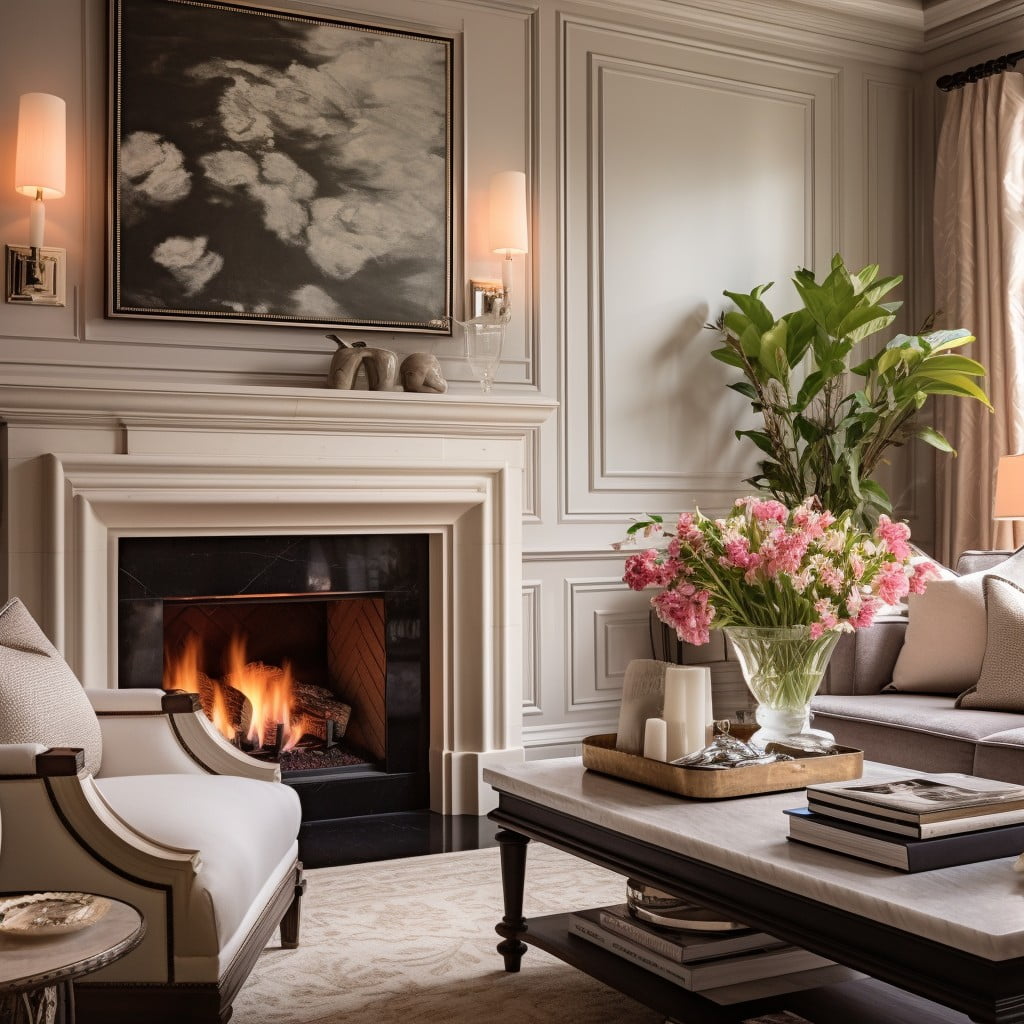
Creating an enchanting aura around your fireplace can dramatically elevate the aesthetics of your living room. Utilizing fluted panels for this purpose is both practical and visually appealing.
1. Material Selection: Opt for high-quality, fire-resistant fluted panels for safety. Metal panels, for instance, make a great choice that also adds an industrial touch.
2. Aesthetic Alignment: Make sure the design, color, and texture of the fluted panels align with your room decor. A stark contrast can be as effective as a seamless blend.
3. Installation Process: You can either go for DIY or hire a professional for installation, depending on your comfort level and budget.
4. Customization: Customize the height, width, and pattern of fluted panels to create a unique focal point.
5. Maintaining Proportions: Keep the surround in proportion to the fireplace and the room. It should look like a natural extension rather than an awkward addition.
Remember, the final effect should be warm and inviting, making your fireplace the centerpiece of your living space.
Use Fluted Panels for Home Office Wall Designs
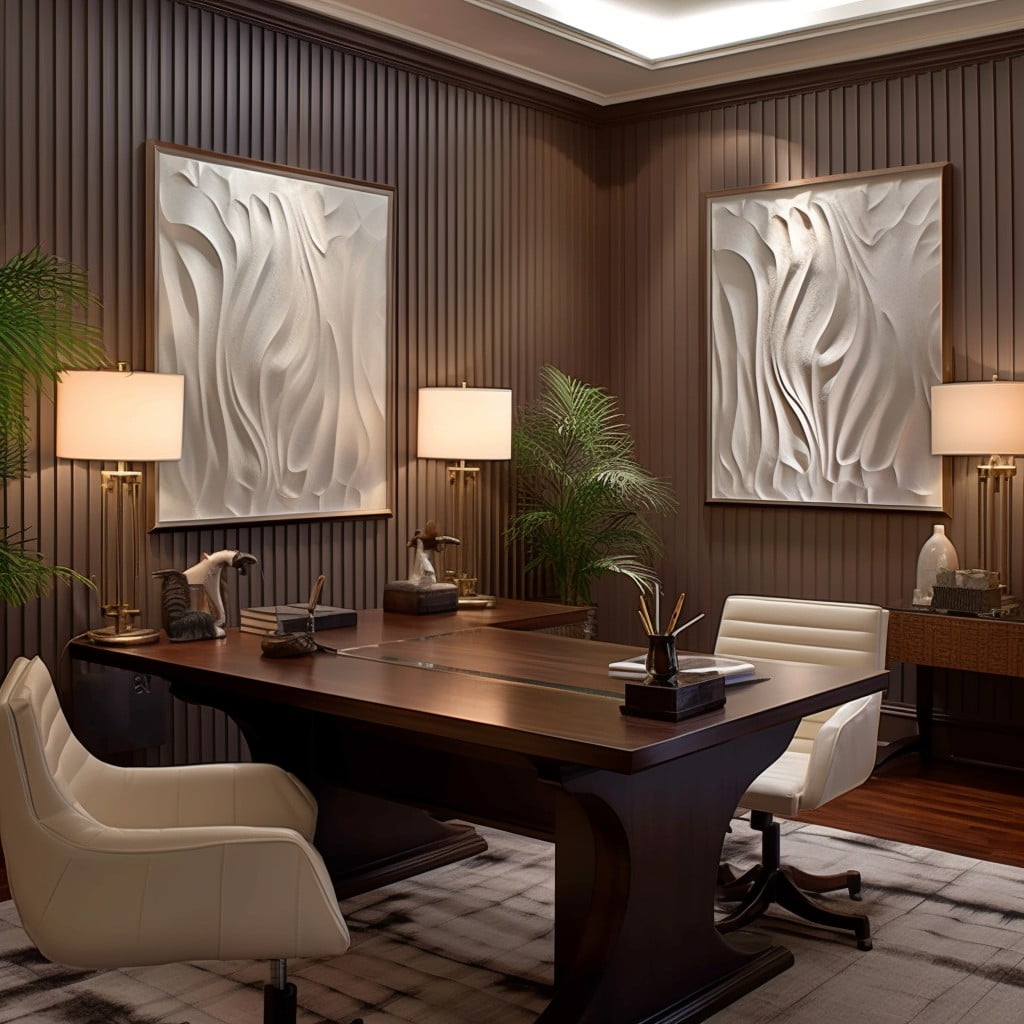
Integrating fluted panels into your workspace can significantly elevate the ambience. They add a touch of sophistication, while pulling together the overall design of the room.
Here’s how:
- Choose Neutral Tones: Opt for panels in white or soft grey to maintain a professional and clean aesthetic, enhancing focus and productivity.
- Vertical or Horizontal: Position the panels vertically to create an illusion of height, or horizontally to create a perception of a larger space.
- Combine with Shelves: Mixing fluted panels with open shelves can provide a practical yet stylish solution for storing books or other office essentials.
- Pair With Artwork: Hanging art pieces or framed certifications can break the monotony, providing an interesting visual contrast.
- Panel Positioning: Rather than covering the entire room, consider installing the panels on a focal wall, behind your desk, for instance. This ensures they add aesthetic value without overwhelming the space.
Incorporating these ideas can provide your home office with an elegant, contemporary feel without sacrificing functionality.
Install Fluted Panels As Bathroom Wall Decor
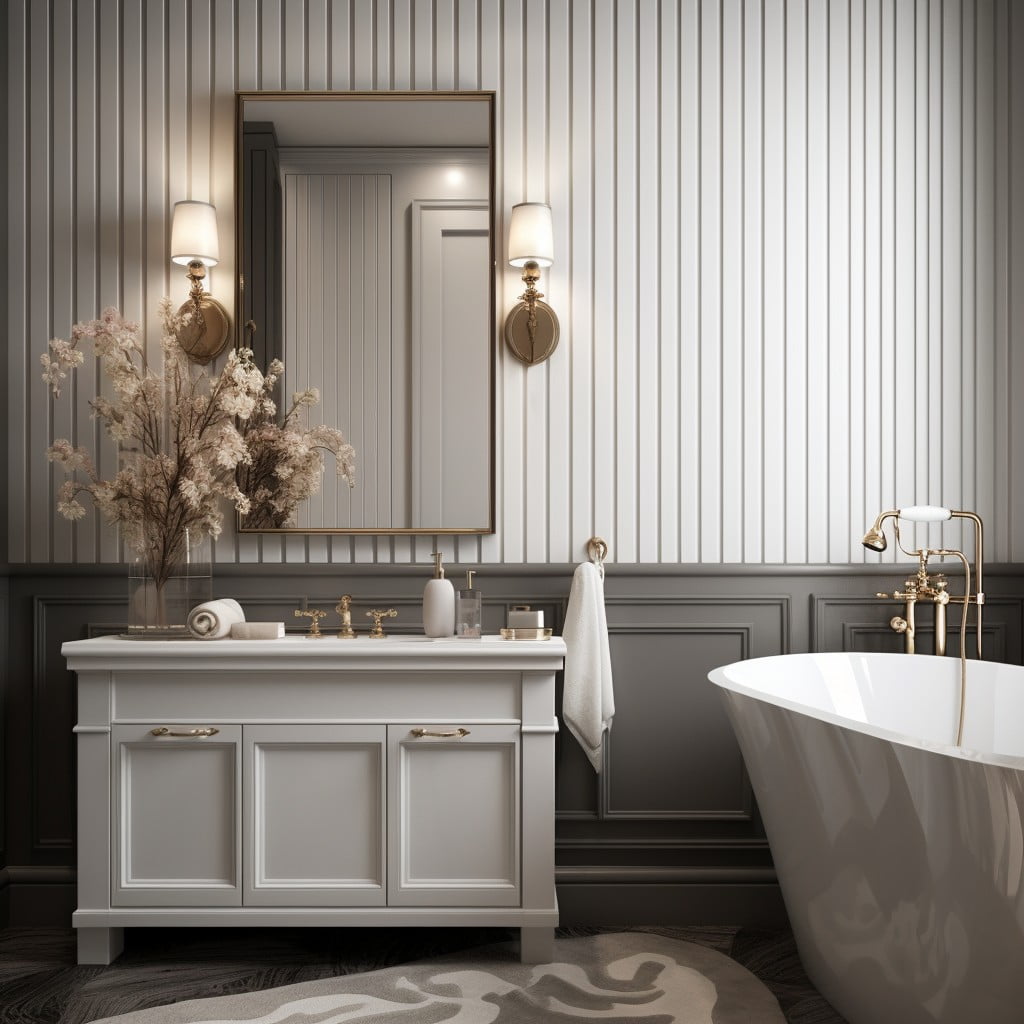
Redesigning the standard bathroom aesthetic with fluted panels can create a touch of elegance. While traditionally used in the kitchen or office, extending their use to the bathroom will lend a visually attractive and texturally interesting look to the space.
Select from a range of materials like wood, metal or PVC, suitable for damp environments. Align panels vertically or horizontally to add depth or height perception. Use a single panel behind the sink for a minimalist touch or cover the entire wall for a statement design. Painting them in light or dark tones can further enhance the look. Remember to finish the panels with water-resistant varnish to maintain longevity.
Furthermore, match these panels with brass or chrome fixtures to tie in the entire look cohesively. This fusion of classical design with modern elements will transform the bathroom into an inviting and stylish space.
Use Fluted Panels On the Exterior for Additional Texture
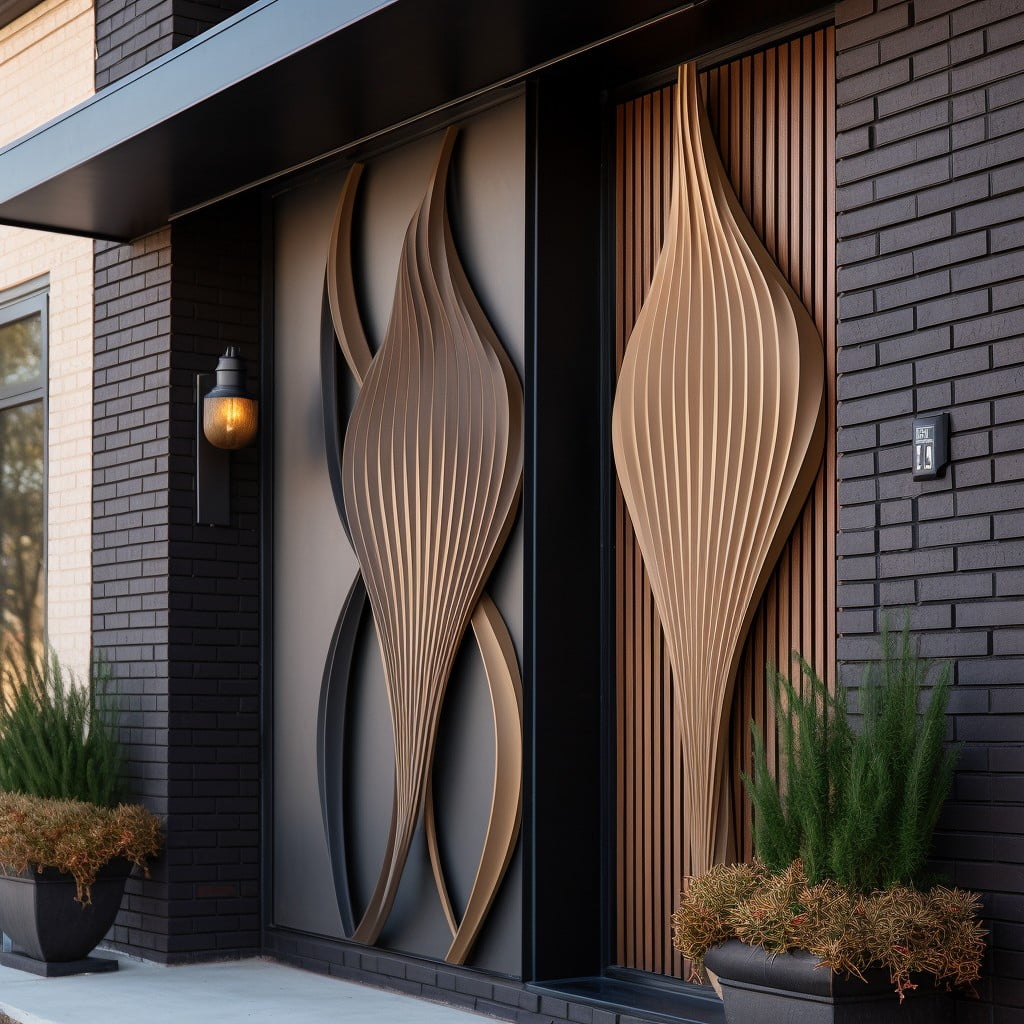
While interior use of fluted panels brings undeniable charm, don’t forget about the embossed impact they have on the exterior facade. Likely, you are considering whether your home requires an additional texture or a differentiating detail. If that’s the case, fluted panels come in quite handy.
Using these panels on the outside provides an attractive contrast to traditional cladding. Their distinctive grooves give surfaces a rhythmic visual appeal, breaking a flat appearance. Opting for weather-resistant materials like vinyl or aluminium ensures they stand up to the outside elements.
You can apply these panels to a feature wall, around windows for enhanced framing, or even on the porch ceiling for an unexpected visual treat. Choosing different panel widths and configurations further expands the design possibilities, securing the precise look you’re seeking.
Remember, precise installation is key for a clean, stylish appearance as well as to ensure long-term durability. It’s advisable to hire professionals if you’re not keen on taking a DIY approach. And finally, color can be your secret tool. Whether it’s subtle shades that blend with the surroundings or bold hues that pop, fluted panels can carry them all, significantly increasing curb appeal.
Design a Room Partition Using Fluted Panels
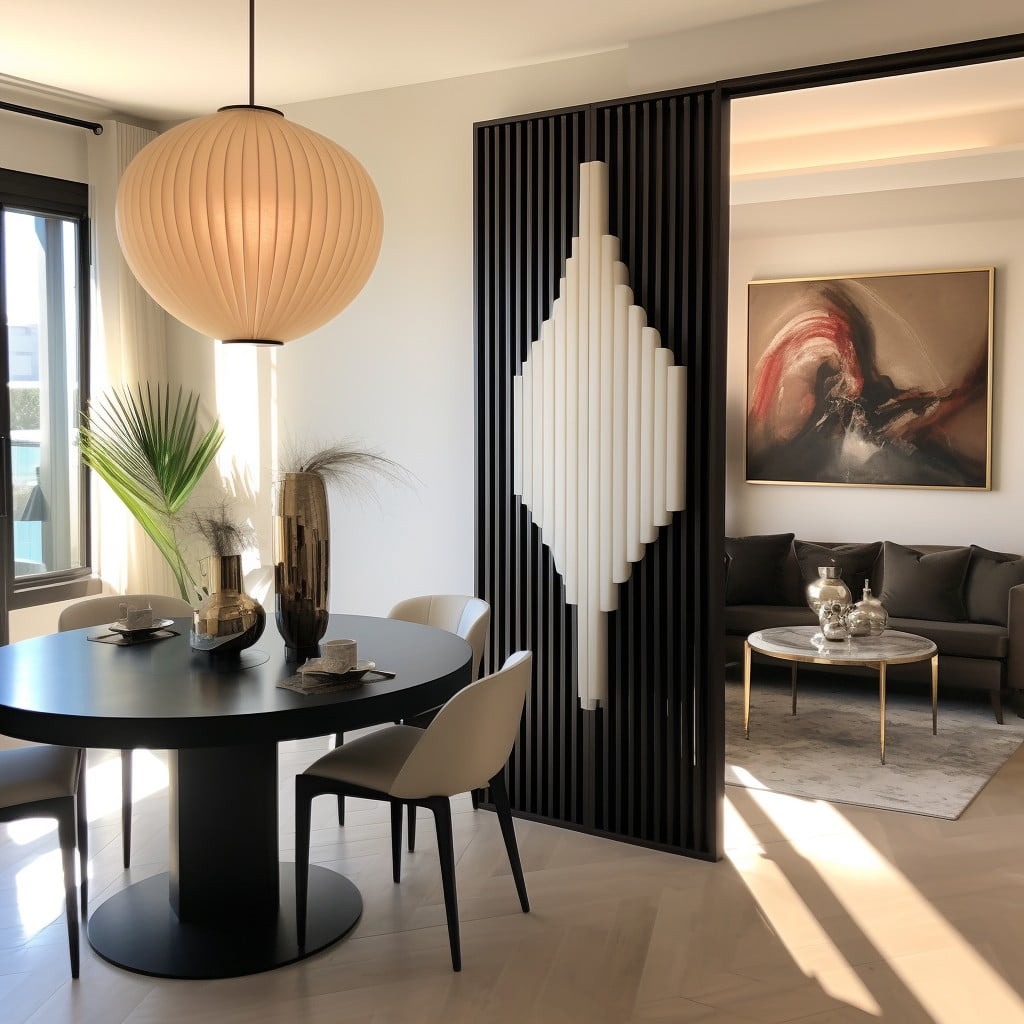
Reimagining your space can be achieved most notably through the use of fluted panels to divide rooms. The linear grooves within these panels add texture and create a visual intrigue that’s hard to overlook. They not only serve the purpose of defining different areas within a room but impart style and sophistication.
Here’s how to effectively use them:
- Choose a suitable material: Fluted panels come in a myriad of options: wood, MDF, or even acrylic. Your choice will depend on the room’s usage and the look you’re after.
- Opt for floor-to-ceiling fluted panels: This enhances the perception of height and adds grandeur to your space.
- Play with light: Integrated lighting at the top or bottom will enhance the dimensional play between shadows and highlights, creating an atmospheric effect.
Remember, it’s your space; don’t be afraid to experiment. Regardless of how you use fluted panels, they’re sure to create an elegant barrier that offers just the correct blend of privacy and openness.
Incorporate Fluted Panels Into Home Bar Designs
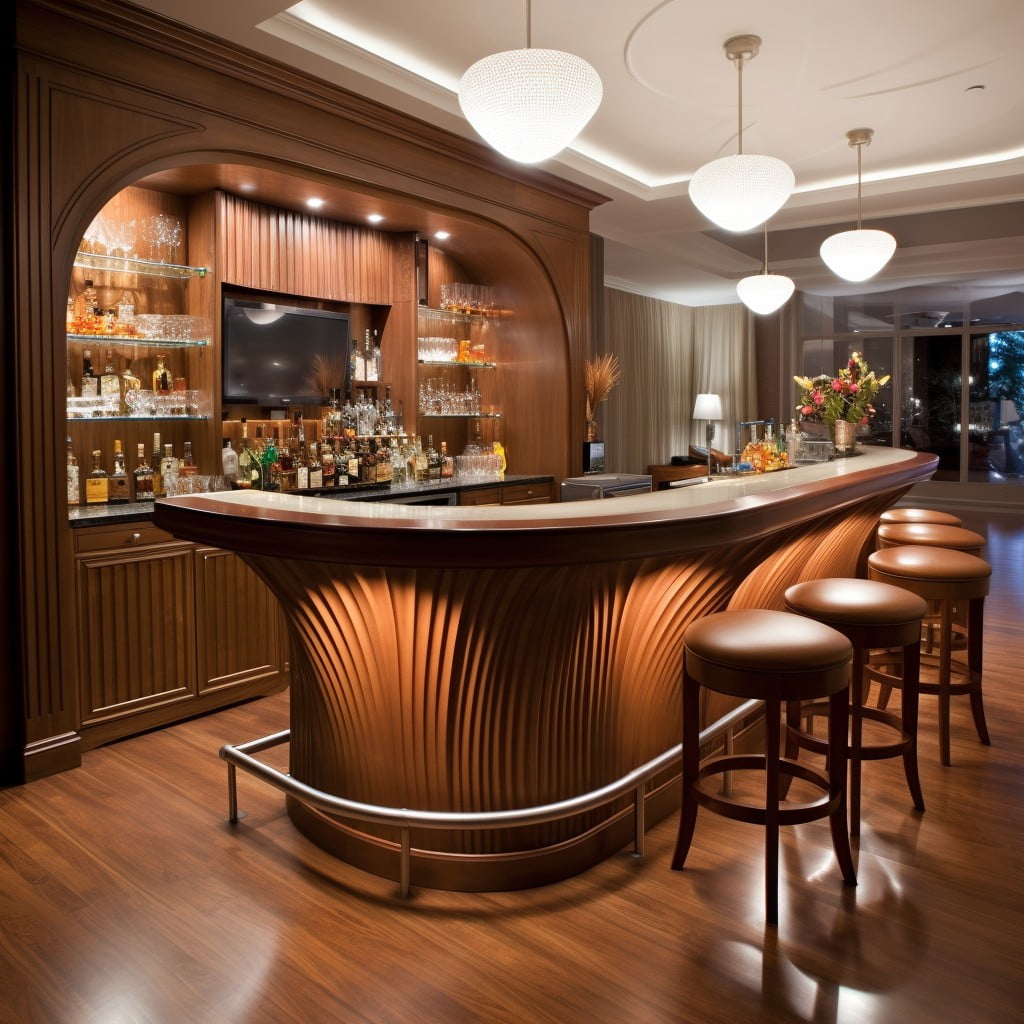
To elevate the aesthetics of your home bar, fluted panels can serve as the key ingredient. Incorporating these architectural elements lends both sophistication and texture, cultivating a tastefully refined ambiance.
Firstly, consider using these panels as the backdrop to your home bar, providing a classy stage to highlight your liquor collection. Combine with mood lighting to accentuate the lines and shadows for a dramatic effect.
Secondly, fluted panels can also wrap around a countertop, creating visual continuity and complementing the bar’s backdrop. Choose a deep, rich color for a more intimate, traditional feel, or a light, neutral shade for a modern, airy vibe.
Lastly, they can be used on the front of bar stools, integrating your seating with the overall design and providing an unexpected design detail.
Use Fluted Panels to Enhance the Dining Room Decor
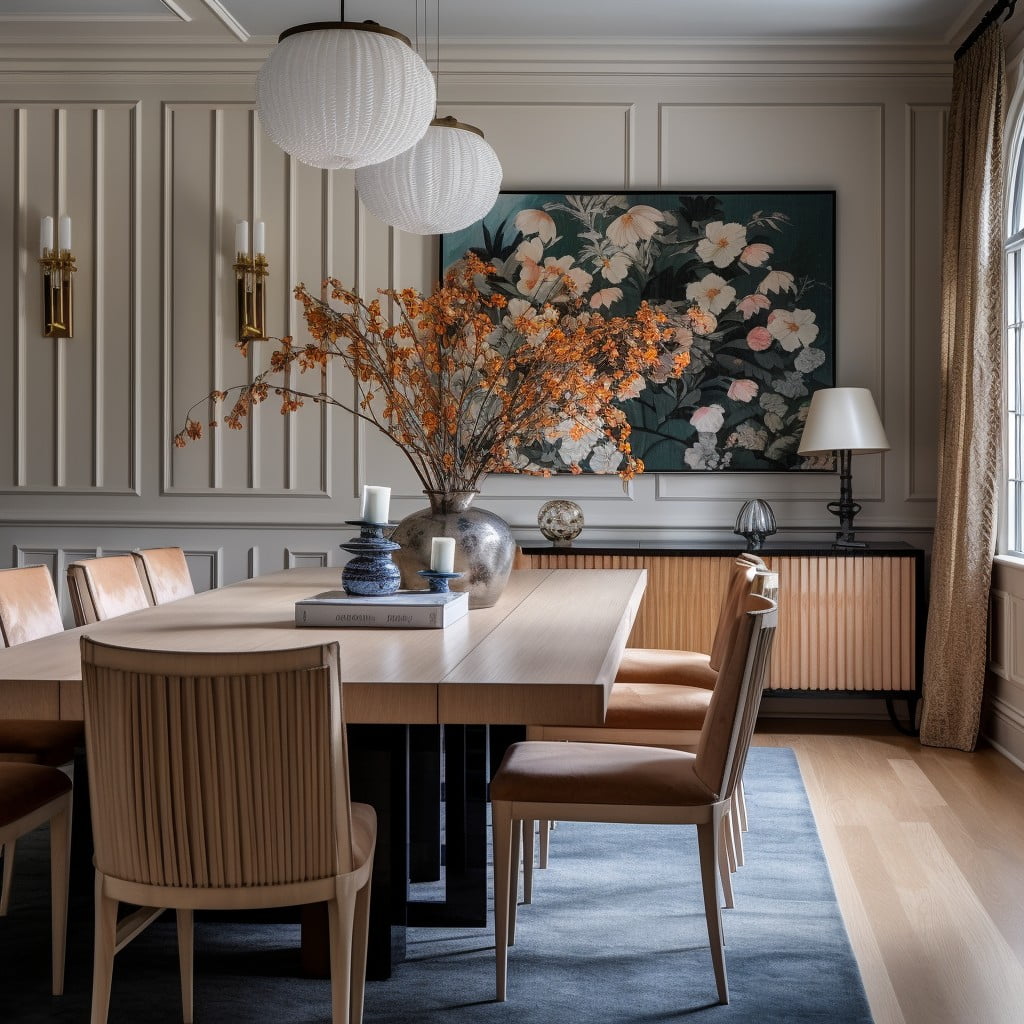
Fluted panels can transform a plain dining room into a space brimming with character and visual appeal. Their linear grooves add an arresting geometry to dining room walls, which can be illuminated with spotlights for dramatic effect.
When choosing materials, remember that wooden fluted panels exude a warm, natural vibe, while those made with synthetic materials offer a wide range of colors and textures for a more contemporary look.
Pair these panels with furniture and accessories that echo the panel’s linear motif to create a cohesively decorated space. Opt to run the fluting horizontally if you prefer an elongating effect, or vertically if you wish to add a feeling of height to the room. Explore varying the width of the flutes for added interest.
By playing with light and shadow, fluted panels can provide depth and visual interest, making the dining room a memorable part of your home.
Install Fluted Panels As Stair Railing Design
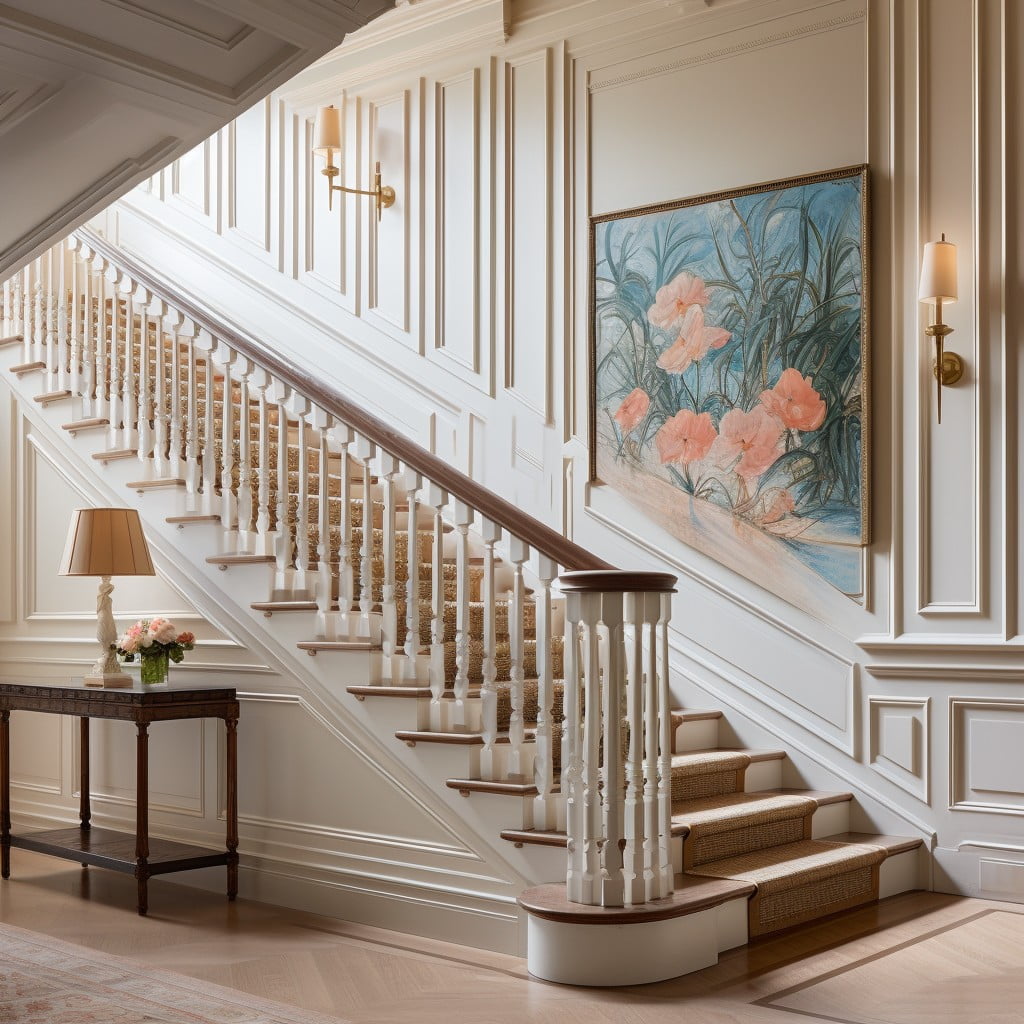
Opting for fluted panels as stair railing design can revolutionize your staircase area. Here’s why:
1. A striking contrast: Against a plain wall, fluted panels add dimension and visual interest. Strategic lighting can further enhance this, casting intriguing shadows on the panels.
2. Variable Widths: Fluting offers flexibility in design. Wide grooves provide a contemporary feel while smaller flutes lend a more classic aesthetic. Choose according to your existing décor.
3. Durability: They are not just decorative but provide strapping support as a railing, ensuring safety, especially with children around.
4. Quick and easy makeover: If your staircase looks uninspiring, fluted panels can dramatically transform the space without an exorbitant renovation.
5. Versatility: Fluted panels are adaptable to different home styles from mid-century modern to bohemian to minimalist, making them a versatile choice in any stairway design.
Remember, aspects such as color, materials, and depth of flutes are all customisable, providing a plethora of design possibilities. Engage a professional if needed, and let your stairway become the highlight of your home.
Create a Fluted Panel Shelf for Display Items
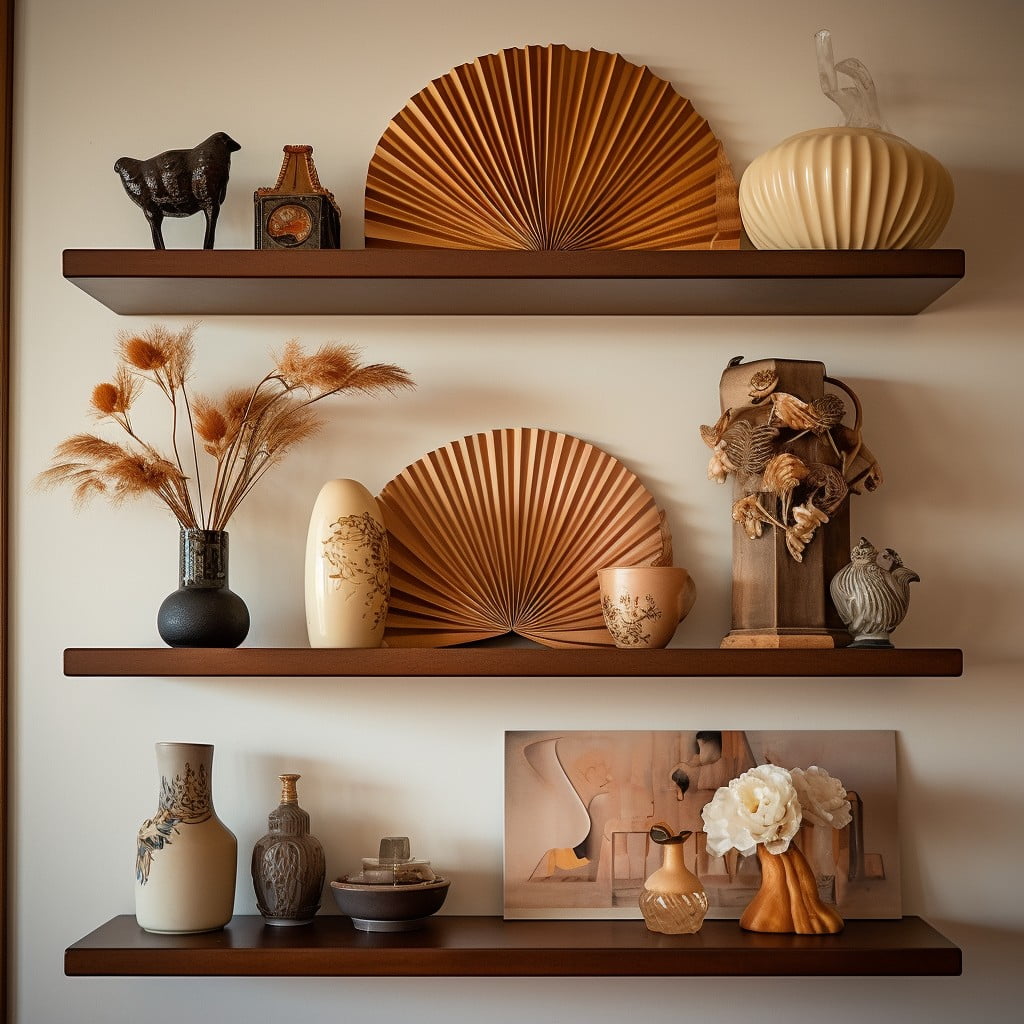
Creating this type of shelf offers a unique design element that adds depth and texture to any room. To get started, you’ll need to choose the right size of fluted panels that correspond with your desired shelf space. Be creative, you can opt for a singular long shelf or multiple smaller ones. The selection should match the space and functional needs of your room.
After deciding on the size, select the color and finish of the panels. While a classic white gives a modern and clean look, darker hues can lend warmth and highlight the linear grooves of the panel. Alternatively, bold colors make a striking statement piece in your room.
Don’t forget the importance of the placement. A focal wall can further enhance the elegance of these shelves. Mounting it above a desk or sofa, or beside a fireplace, allows for practical usability without compromising on design.
The final step is dressing up your shelf with your select display items. Whether books, framed photos, plant pots, or other cherished trinkets, these objects will help personalize your space, making it all that more special with a fluted panel backdrop. Ensure the displayed items complement the color and finish of your chosen panel for a cohesive look.
Design a Fluted Panel Window Trim
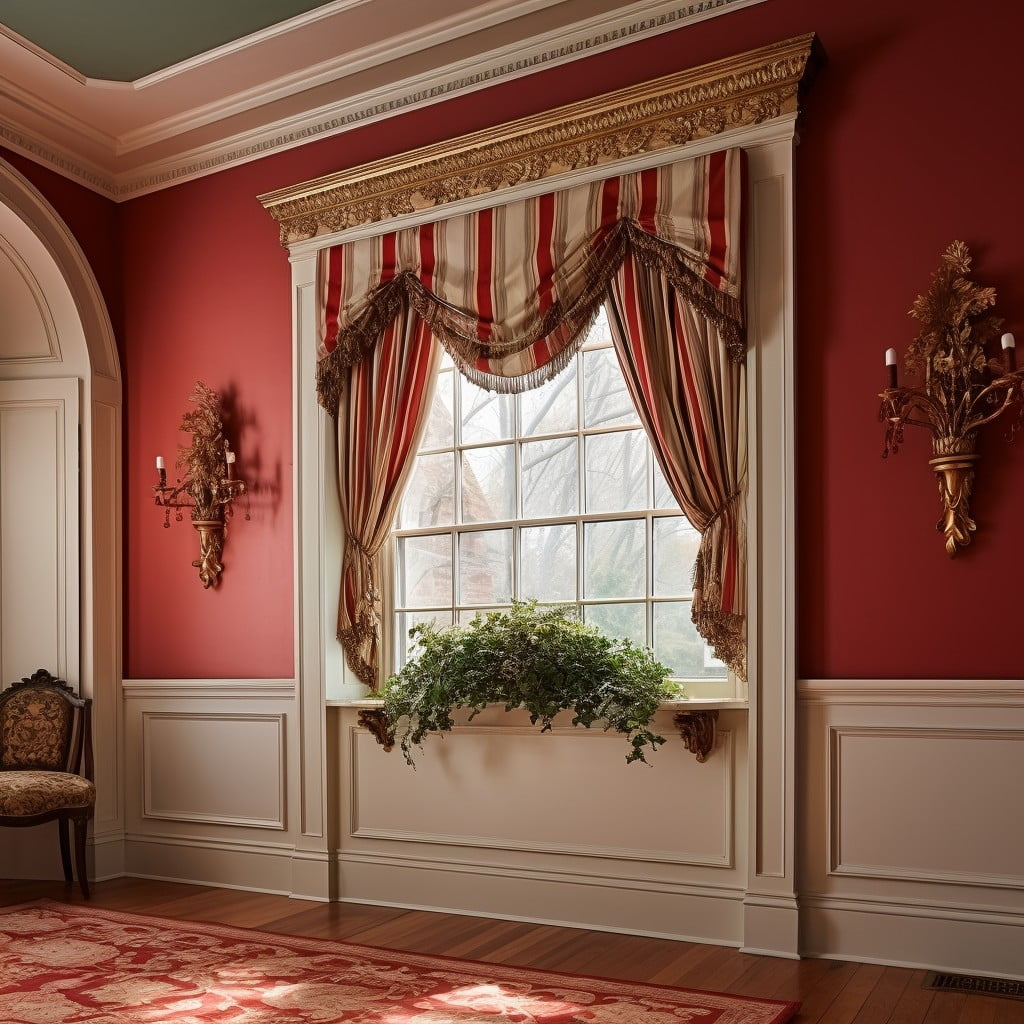
Moving beyond traditional window trims, the incorporation of fluted panels adds an extra layer of interest. This concept delivers a sleek, modern look, with a touch of traditional design.
Here’s how you can get started:
1. Choose the Fluted Panel Style: Consider the style of fluted panel that best complements your room. They range from deep, broad flutes to finer, shallower designs. The choice is dependent on whether you want a subtle or dramatic effect.
2. Measure Accurately: Obtain precise measurements of your window for the fluted panels. This step is crucial to getting a neat finish and ensuring the panels fit perfectly.
3. Preparation and Installation: After purchasing your panels, prepare them for installation. This might include painting or staining them to match your interior design. Then, install the fluted trim around your window, securing it with suitable adhesives or nails.
4. Completing the Look: You might want to add a matching sill or header for a cohesive design. You could also consider pairing the fluted trim with traditional curtains or modern blinds.
Remember, while fluted panels add architectural interest, they also provide a tactile element to your window trim, appealing on both visual and sensory levels.
Incorporate Fluted Panels in Nursery Room Designs
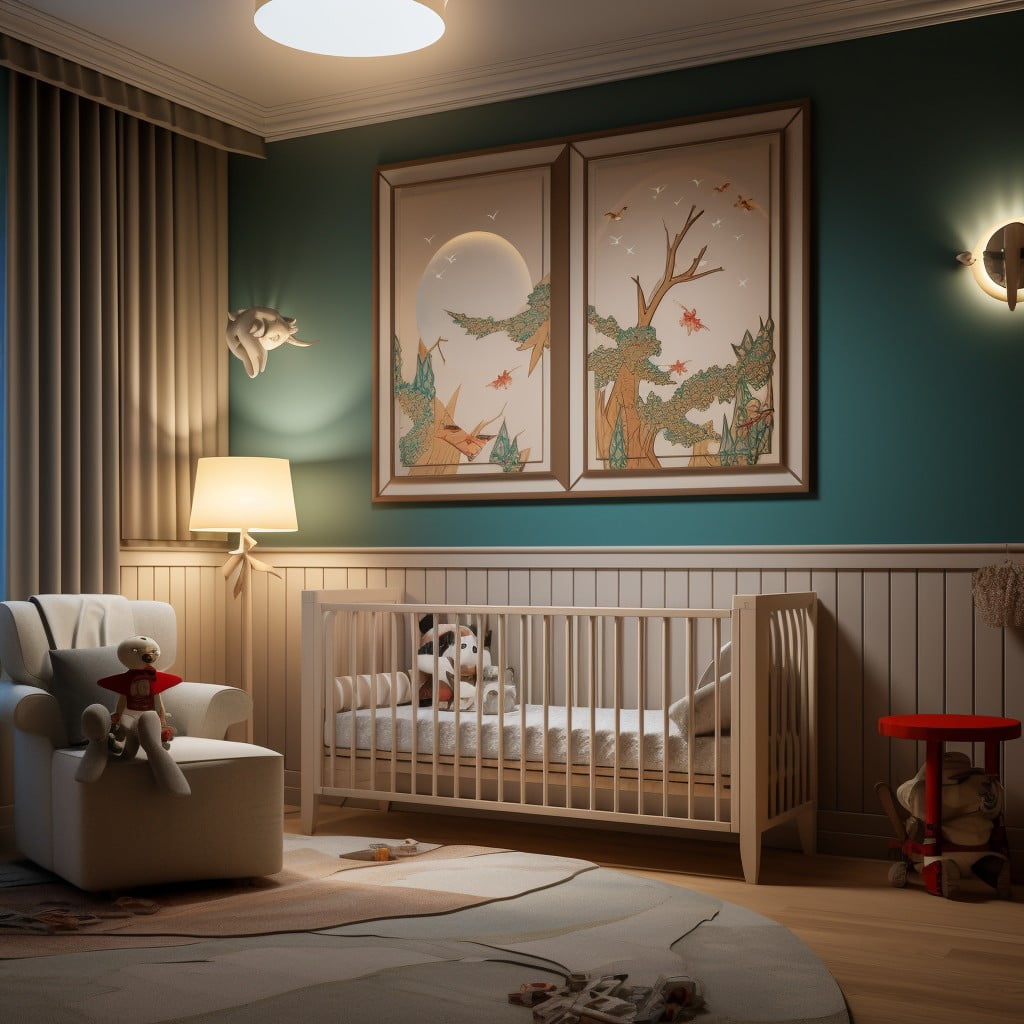
Choosing a design for a nursery room can be an exciting and rewarding experience, made even better with the inclusion of versatile fluted panels. These panels offer a stylish and contemporary alternative to traditional nursery decorations, giving the room a unique, textural appeal that’s pleasing to both parents and little ones.
1. Walls: Give the nursery walls a delightful upgrade by adding vertically arranged fluted panels. This creates an elegant and subtle texture which can enhance the ambiance of the room.
2. Furniture: Customizing the nursery furniture like wardrobes or cabinets with fluted panels can add a chic and fashionable touch, making it functional yet sophisticated.
3. Shelving: Play with design by using fluted panels to create stunning display shelves. They can house books, toys or cherished mementos, adding personality to the room.
4. Feature Pieces: A standout piece like a fluted panel crib not only elevates the room’s decor but also adds a stronger sense of safety and coziness.
Remember, fluted panels come in a variety of colors and sizes, thus enabling you to keep the room aesthetic soft and calming or vibrant and stimulating as per preference.
Use Fluted Panels for Closet Door Designs
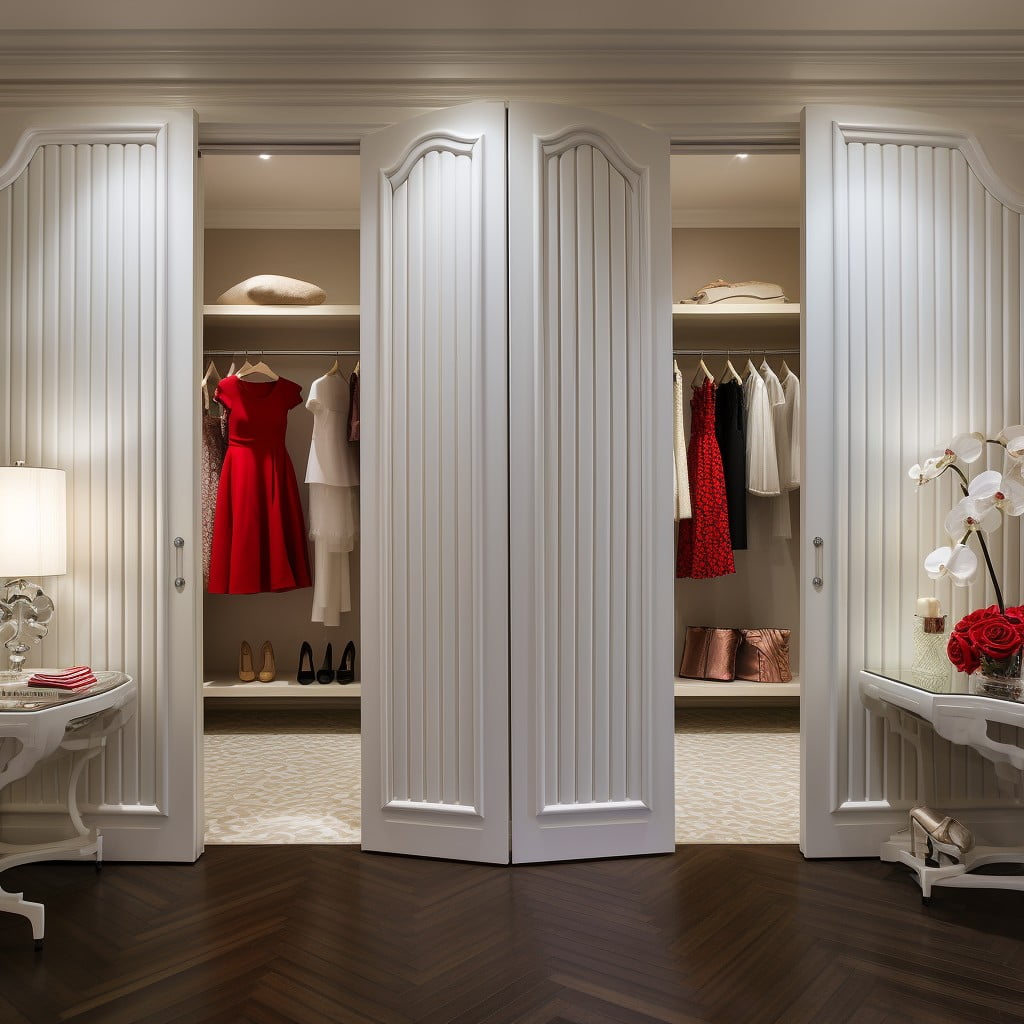
Fluted panels can elevate the look of your closet doors dramatically. There’s simply a classic charm about these grooved designs that can suit anything from modern minimalist to traditional or mid-century interiors.
1. Choosing the Right Design: Options range from simple vertical grooves to more intricate patterns. Consider the style of the room before deciding.
2. Selecting the Material: Common materials for fluted panels include wood, MDF, or thermoplastic. Wood offers a warm, traditional look, while thermoplastic is easily painted and offers more flexibility.
3. Color Choice: The panel color can either blend with the prevailing room color or be a bold contrast to make the closet a focal point.
4. Adding Details: Consider adding doorknobs, pulls or handles that complement the fluted design to complete the look.
5. Professional Installation: While DIY installation is possible, professional installation may be necessary to ensure panels are properly aligned and secured.
Remember, adding fluted panels to your closet doors can be a simple but impactful way to add texture, dimension, and character to your room.
Design a Fluted Panel Cabinet in the Laundry Room
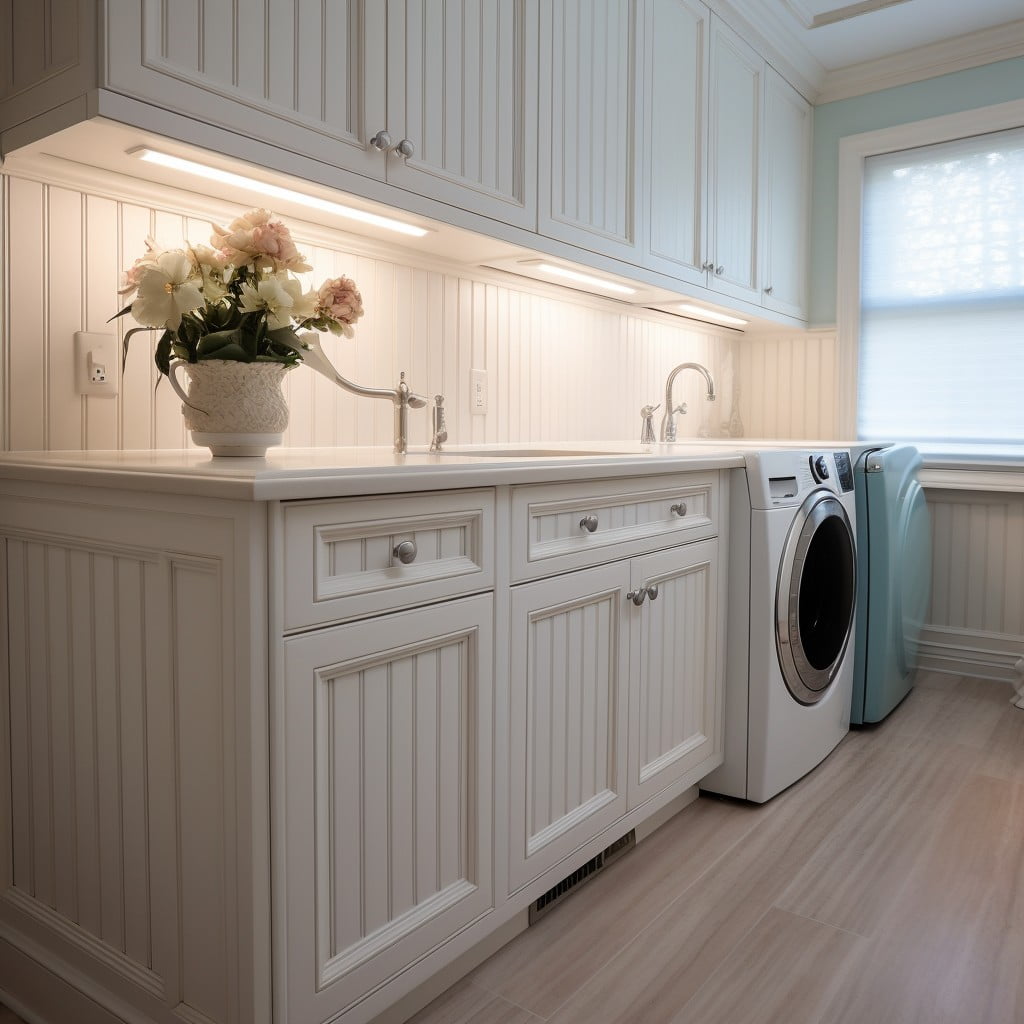
Fluted panels beautifully marry design with practicality in the laundry room. Here are a few methods for executing such a concept:
1. Using Various Widths: Use fluted panels of different widths to create a sense of movement and break the monotony.
2. Playing with Height: Consider running the fluted cabinets up to the ceiling to draw the eye up, making the room seem taller. Also, it provides extra storage.
3. Balancing Colours: Opt for lighter colors such as white or pastels to make your small laundry room seem larger and more welcoming, or darker tones for larger rooms to add depth.
4. Mixing with other finishes: Use a combination of fluted panels with flat-front or glass-front cabinets to create visual interest.
5. Incorporating Multi-Functional Systems: Plan shelves or hooks on the fluted panel to hang items for quick access.
6. Lighting: Add under-cabinet lighting to enhance the ridges and shadows of the fluting, providing your laundry room with a warm and inviting glow.
Remember, while aesthetics are important, functionality should always be your fundamental factor whilst planning your fluted panel cabinets.
Install Fluted Panels Under the Kitchen Island Bar
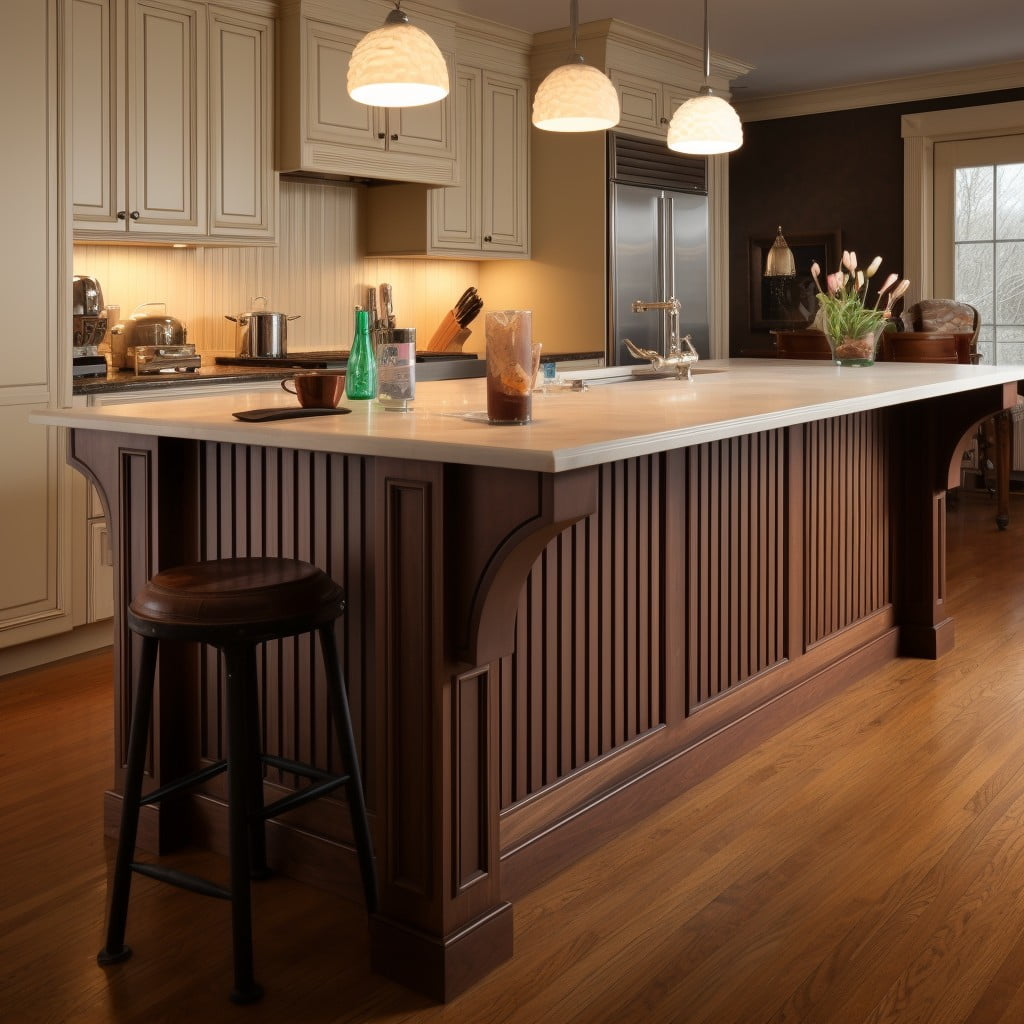
Incorporating fluted panels under the kitchen island bar offers both a unique effect and unexpected texture that magnifies the aesthetic appeal. To achieve this, consider these points:
1. Choose the Material: From wood, metal, or thermofoil, select a material that complements the kitchen’s overall design theme.
2. Select the Design: There are various styles and patterns available, including vertical, diagonal, or wave-like textures. Remember, the pattern should blend seamlessly with the kitchen’s decor.
3. Install Professionally: Ensure correct and precise installation. This may require hiring a professional to avoid any alignment issues or errors because the beauty of fluted panels lies in their uniformity.
4. Paint or Stain: This depends primarily on the chosen material. Wood panels can be either stained or painted, while metal ones often look best when left natural.
5. Maintenance: Remember that maintenance is key. Regular cleaning will improve longevity and sustain attractiveness.
Undeniably, this touch sends an inviting and warm message to the kitchen area, enhancing its overall guise while offering a unique point of interest.
Recap:
